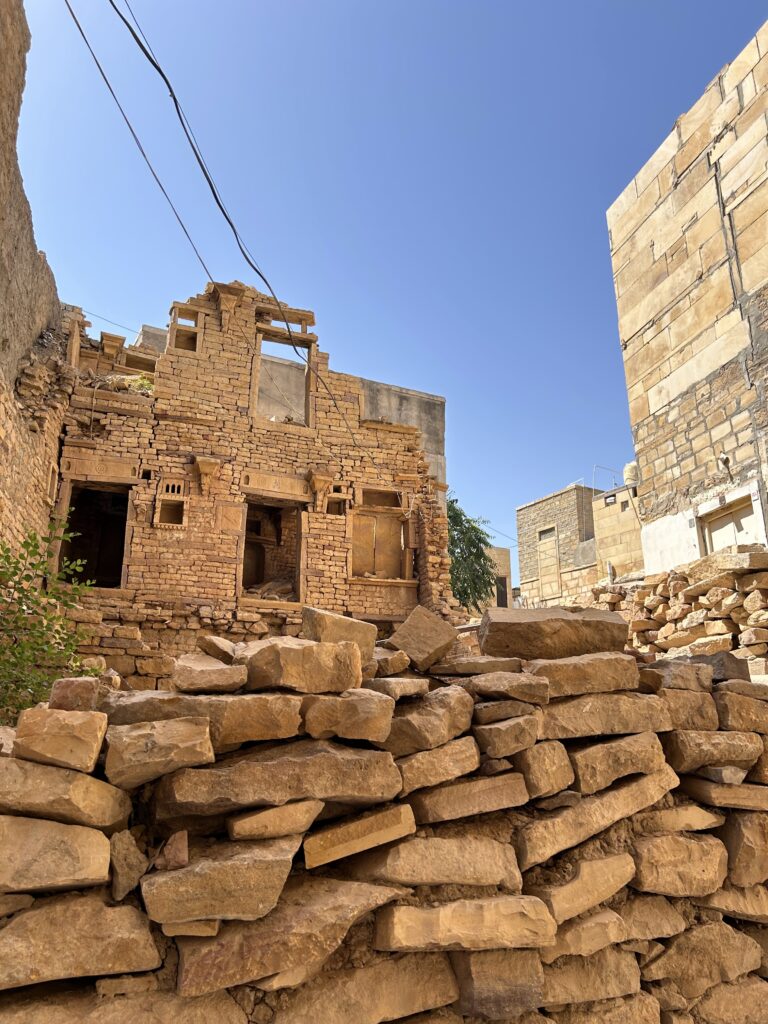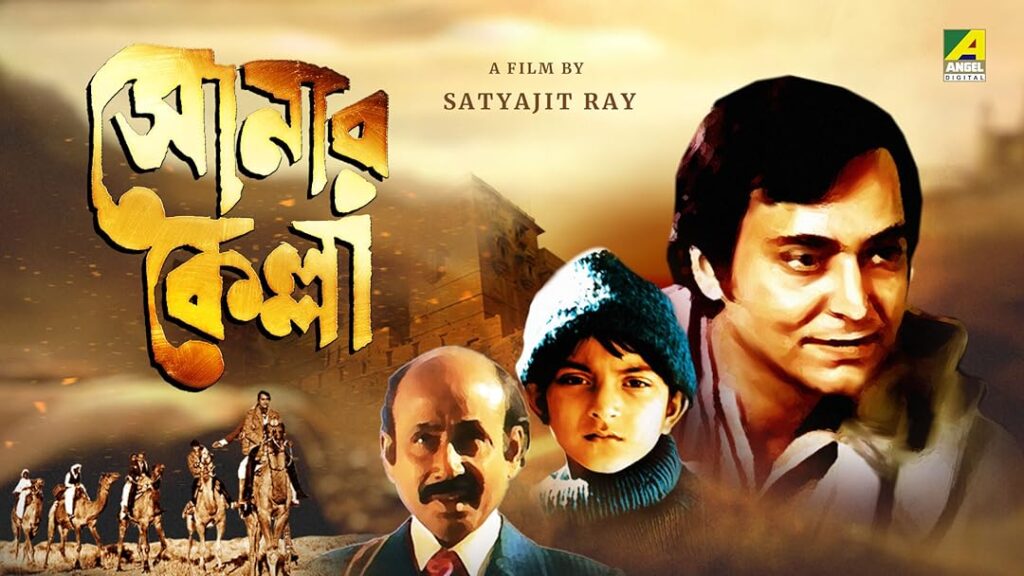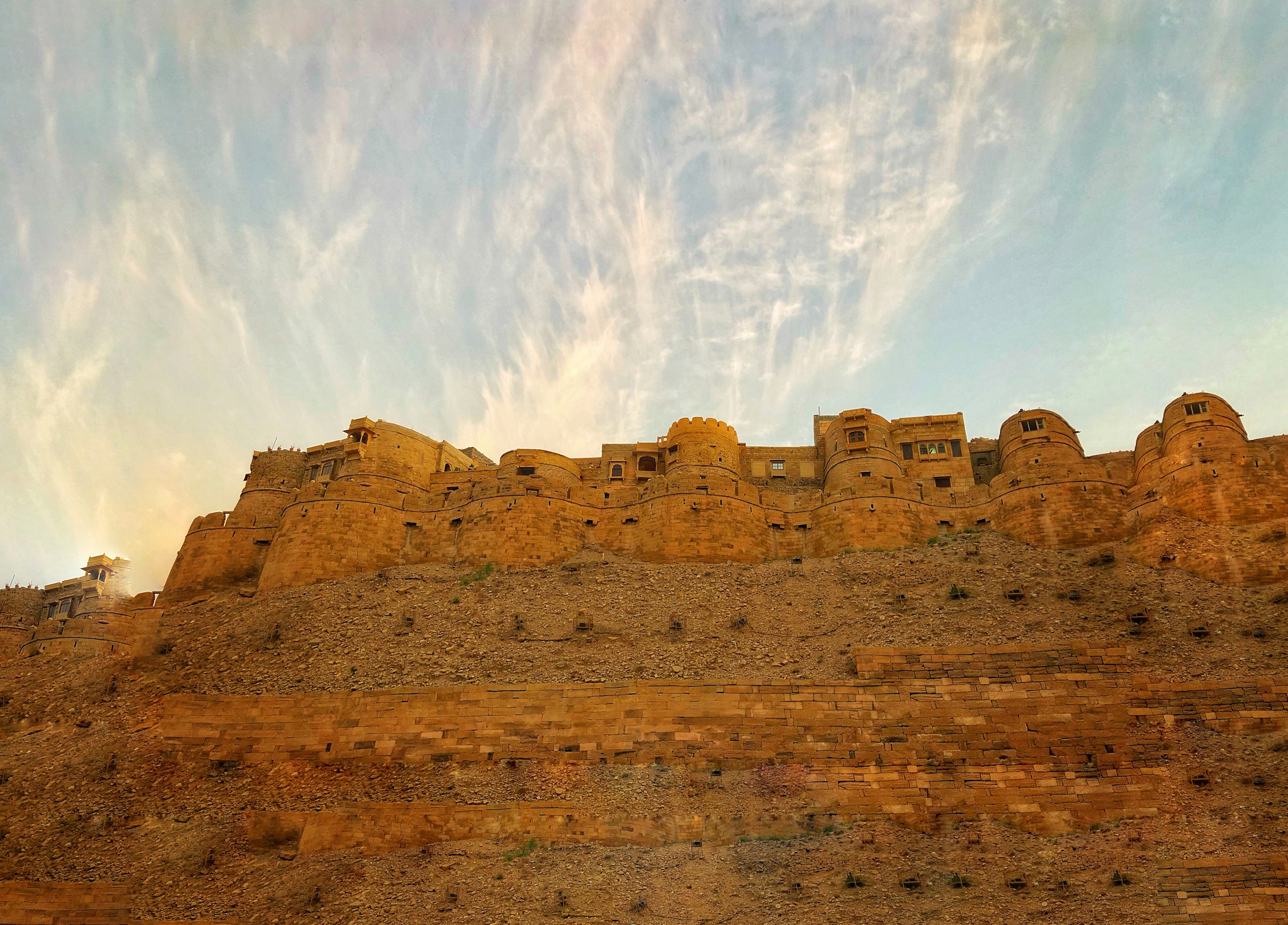We boarded the train at the last minute, hustling with the crowd inside an unreserved coach, finally making our way to our allotted seats. Gasping in the melange of farts amidst curious and intrusive co-passengers, we tried to escape the silent tortures of our neighbors by shifting our focus elsewhere. Throughout our journey to the Jodhpur junction, the entire night, we kept watching a movie on the phone – Sonar Kella or The Golden Fortress (1974) written and directed by the Oscar-winning Bengali filmmaker Satyajit Ray. Before I reached our destination and witnessed the majestic fort of Jaisalmer in front of my eyes, I wanted to recall childhood memories of the fort that appeared to me for the first time in life through the television screen.
Bengalis associate a particular emotion with Jaisalmer, especially the Jaisalmer Fort. Based on his mystery novel Shonar Kella (1971), the Indian author, musician, and Oscar-winning filmmaker Satyajit Ray created a detective media franchise titled Feluda, which was introduced on screen for the first time in the movie Sonar Kella or The Golden Fortress (1974). This movie turned out to be a blockbuster hit. The golden hues of a majestic fort spilled out of the screen, enamored by the captivating tales of historical battles, hidden gems, rebirth, parapsychology, private investigators, fraudsters, guns, and goons insinuated into the hearts of millions of Bengalis whereby the Jaisalmer Fort made a place in the popular Bengali imagination (and travel bucket lists too!) – like an indestructible monument. In the movie, a six-year-old schoolboy, Mukul Dhar, from a middle-class household, is a Jaatishwar who can recall memories of past life. Ray, a craftsman of moving images who seasoned himself in the world of media and advertisement, did a remarkable job in setting up the future market for Rajasthan Tourism by situating the ruins of the Jaisalmer Fort on a global map, primarily through the depiction of Mukuler baari or the ruins of Mukul’s house.

Named after the 12th-century Rajput ruler Rawal Jaisal, the Jaisalmer Fort is the second oldest fort in Rajasthan, built and named after the founding ruler of the city in 1156 AD. Ray connected the past and the present of the Indian subcontinent through Mukul’s lens, which was seen traveling between two lives and distinct periods. Torn between the past life in Jaisalmer (13th century) and the present life in Kolkata (20th century), Mukul grew insomniac. He would wake up in the middle of the night and paint images from past life on the white pages of a drawing book. The camels, peacocks, precious gemstones, battlefields, and forts – none of those he has seen in this lifetime. Recuperating memories anchored around the lost homeland situated inside a shining fort that exhibited a golden hue against the reflection of light. Almost half a century later, on this day, Ray’s coinage of the term Sonar Kella or the Golden Fortress has earned Jaisalmer the stature of the Golden City. Today, the extravagant hotels and homestays mushroom in and around the fortress city market while encashing Ray’s terminology, such as Sonar Quila, Sonar Kella, and so forth. drawing in a significant number of Bengali pilgrims from the east who visit the fort to witness the cinematic ruins of Mukuler baari or Mukul’s house.
Ray: The Poster Boy of Jaisalmer
My filmmaker friend told me about the influence that Mr. Ray exerts on the lives of the people of Jaisalmer. People have consecrated photographs of him inside the fort, he remarked. I thought Mr. Ray must have acquired the status of a revered man in Jaisalmer, who is regarded with high esteem. With a heart full of curiosity, we entered the fort. After walking with our guide for about five minutes, even before encountering Mukuler Baari, we saw a retail shop on our way—a glass shelf showcased bowls and cutleries of various shapes and sizes made of yellow sandstone. If one can recall, the bowls are almost replicas of the same bowls and cutleries captured by Ray in his movie. Right beside the shelf stands a signboard and a picture of Mr. Ray. Below his photo, the signboard contains a fascinating note that caught our attention—a note in cryptic language. It goes like this:
“Satyajit Ray. Sonar Kella (1974). Ei mohaan chitro porichaloker karonei Bangali porjotok proti bochor Jaisalmer’e ghurte aashen”. It can roughly be translated as “Satyajit Ray – the famous director of Sonar Kella or the Golden Fortress (1974). Because of this great filmmaker, Bengali tourists visit Jaisalmer annually”. However, the phrases were not ordered in the sequence I had just read. They were phrased haphazardly. Let me reread some words while following the precise order or dis-order in which they were arranged. On that note, Satyajit Ray has been spelled as Satjajoti Ray. Sonar Kella (Golden Fort) was spelled as Sonenar Kalela (gibberish). Chitro (film) was spelled as Chotir (slippers). Porichalok (director) was spelled as porichalkore (gibberish). Proti bochor (every year) as poroti bichor (gibberish). Porjotok (tourist) as pirjotok (gibberish). Ashen (visits) as ashone (seat). And finally, Jaisalmer was spelled as Jaisalmori.
At first glance, one would assume that it is misspelled Bangla, which explains to the reader the significance of Satyajit Ray’s film Sonar Kella (1974), which converted the Jaisalmer Fort into a tourist destination, especially among Bengali tourists. Although it may appear as misspelled Bangla, I am not sure to consider it a mere misspelled artifact. It was something more than that. I have a range of fleeting thoughts. Firstly, is it possible that none of the visitors to date have spotted the ‘error’ in the text? I should not be the first one. Knowing that Mr. Ray is an iconic figure in Bengal, as explained on the signboard, the misspelled words and incorrect phrases would likely annoy a visitor who holds Ray’s work in high esteem, especially the language he used as the primary literary device while writing the novel. I wonder how Mr. Ray would have reacted to this. This incident would have reaffirmed his perception of the Indian audience, who are “fairly backward” and can’t even spell words correctly despite their desire to communicate. The shopkeeper has not failed to deploy Mr. Ray’s popularity while exercising his marketing brilliance. Then, what does this error tell us about him and, most importantly, Jaisalmer? I tried to comprehend misspelling as a code to unfurl a hidden meaning.

Preservation of Ruins
Firstly, it tells me about the power of stories. Stories that establish transcultural links and senses of belonging across languages and cultures. These links are harbingers of prosperity and wealth, for instance, through promoting infrastructure and tourism in Rajasthan. Most importantly, such networks amplify the exchange of meanings across space and time. But it also tells us about inadequate friendships. Hasn’t the shopkeeper placed unquestioned faith in the cognition of computers or humans who failed to qualify the accuracy of phrases and spelling? I see that the lack of friendships has championed the battle of storytelling, where a missing friend could have kindly pointed out the error and demanded rectification for good. The ones the shopkeeper has trusted have unfortunately betrayed him, knowingly or unknowingly. The poster became a matter of ridicule to the enthusiastic visitors. Some smirked, chuckled, and laughed in his absence without caring to tell him about the error. I am certainly one of them. Thinking of another possibility, what if someone has pointed out the error and advised him to rectify the poster? Then, what exactly happened that he retained the inaccurate poster exhibiting the ruins of a Bangla syntax? Instead of looking at it as a lack of meaning, I see it as an act of meaning-making that comes from preserving ruins. Here, the inaccurate collage of words and phrases has been cautiously or unknowingly preserved on the signboard that bears the marks of unfaithful transactions of meanings–unfaithful friendships.

When I asked my guide to show the renowned site of Mukuler Baari or Mukul’s house, he gave me a word of assurance. Gajendra, our tour guide, takes all his tourists to that spot, especially the Bangaali tourists like us who are enthusiastic about the site. He shared an interesting fact: the managing committee of the Jaisalmer Fort has been maintaining the ruins of Mukuler Baari, as shown in the movie. This would preserve the charm of the shooting spot among tourists. We learned from him that the neighboring Jain temple beside the ruins of Mukuler Baari had emerged as a sacred site of shelter for the Jain traders of the ancient Silk Route. Today, the ruins of Mukuler baari have become a holy site of pilgrimage for Bengali tourists who desire that the sacrality of Ray’s cinematic masterpiece be preserved in the untouched and undiluted organization of ruins.
I assume tourists come here to witness the power of stories. Stories told through ruins. Ray has rendered meaning to the ruins of the fort by inserting a magical device, i.e., (Mukul’s) memory. Through the reminiscence of previous life, rebirth, and feelings of longing, the craft of storytelling through moving images has breathed life into the disordered collage of crumbled bricks and yellow sandstones. I am sure there is a politics behind the preservation of ruins. There is a politics behind keeping things intact. Ruins are preserved when they secure a coherent presence in the world. Ruins are not ruins in that sense. When they enter the imagination of people, they can cement thoughts, ideas, and beliefs. They can sow the seeds of feelings and emotions. The ruins are the coherent architects of cultural desires. Therefore, the efforts of preserving ruins are always directed towards preserving the coherence of meaning attached to the ruination of things because meanings bring people together.
Mukul, I, and Our Struggle for Restoration
The preserved ruins of Mukul’s house inside the fort were a collage of broken and crumbled stones that lay organized, misplaced, disjointed, and unglued. The conscious absence of cement, cow dung, and cow urine used to renovate and preserve the other parts of the fort promises to endure the process of ruination. Likewise, the unorganized collage of Bengali look-alike terms standing beside one another as ruins of a distorted Bangla Byakoron or Bengali grammar. It ruined the byakoron or grammar of the language, producing a distorted legibility. But what exactly lay behind these ruins? Does the collage of grammatical ruins explain anything beyond the ruination of language? What does the conservation of a linguistic ruin mean, especially in a place where people gather to witness the captivating interplay of stories?
To find this out, for a moment, I became Mukul. Instead of witnessing the collapse of a house, building, or the fleeting memories of a bygone life-world, I witnessed the collapse of a syntax. The Banglaa syntax functions as a vehicle of meaning-making that enables specific expressions to emerge in the world. Hence, the collapse of a syntax or a language is the collapse of expressions and meanings. When syntax fails to capture and disseminate the unique expressions of a culture, or when it fails to be understood, realized, and sensed, it is the collapse of meaning.
Let us recall the climax again. Mukul is looking at the ruins. The camera pans towards his face. He began crying. He continued to look at the ruins and kept weeping. While the ruins stood before his eyes, Mukul pictured a place that once was home. In this mind, he could conjoin the broken blocks of stones together. One beside the other. He must have imagined the house as a concrete building – the shape and the structure of which were filled with meanings once and, unfortunately, are lost in his present life. In his mind, there was an interplay of meaningful order in the concrete structures that now stand destroyed. It is the destruction of this order that instigated the catharsis of loss. Mukul wept at the loss of a structure, an order that conveyed the essence of home. When we lose our homes and stand distanced from friends, loved ones, and families, the order of life is lost. Such feelings of loss and longing can pertain to this life only, even in the absence of the memory of a previous life.
I felt a sense of loss when I looked at the signboard and read through the broken phrases. I struggled to situate the presence of an order in them. In my mind, I was trying to restructure the fragments and render legibility to the congregation of illegible words. Just like Mukul, who visualized the presence of a lost home in the disordered blocks of yellow sandstone, I was constantly trying to visualize a coherence between words and phrases that could carry some meaning instead of appearing gibberish. I tried to restructure the words, reordered the syntactic framing, and imagined the correct sequence of phrases – all of it, inside my head, to create some meaning for myself. This imaginative and intuitive gymnasium was an act of recuperating the lost ruins of a language, i.e., Bangla, which collapsed on the renditions of a digital print.
The Loss of Meaning
If I look at the case from a third-person perspective, there was a disorder. The reader had to intuitively intervene in the text and infuse an order within it. Therefore, my efforts and Mukul’s efforts are almost the same, although they differ in varying degrees of emotional intensity. Both of us mentally envisioned the presence of an order. There were remnants of ruins lying before us, but we compared them with solid structures. We converted into witnesses of collapses. For Mukul, it was perceived as the collapse of a home he once resided in and the collapse of a life he once inhabited. For me, it was the collapse of a language that failed to render comprehensibility and legibility of the meaning. I call this a collapse or loss of meaning. Here, linguistic exchanges happen across transcultural terrains, but the exchange of meaning disappears. Languages, things, and objects bear the distinctiveness of cultures. That is why, when languages travel the world, but their meanings don’t, or when objects and things are carried to places, but their essences are compromised, isn’t it a loss of meaning?
But I want to end this article on a positive note, with feelings of contentment instead of dissatisfaction. It is because the act of contemplating on the ruins has not been a meaningless pursuit so far and I have not returned empty-handed. In recuperating the unsung tales of Jaisalmer, I have tried to feel the pulse of the city. And in doing so, I was filled with the joy of an accidental discovery. I realised that the heart of the city lies not in the monumental pillars of the fort, but in the indestructible ruins at its feet.
